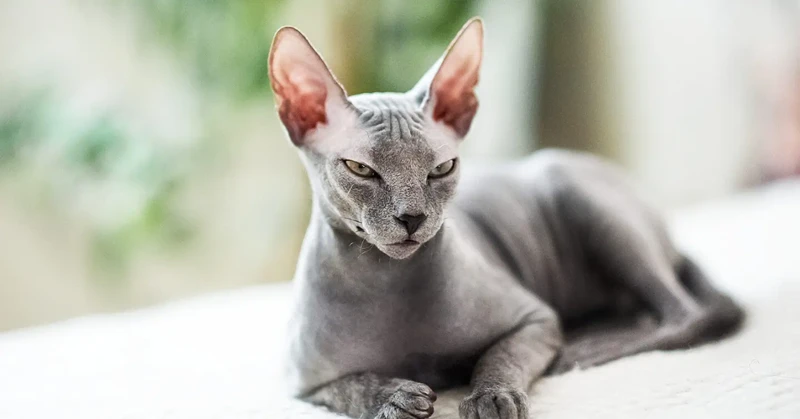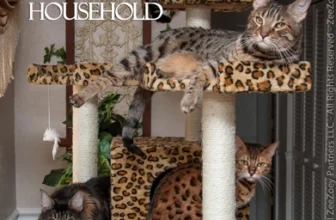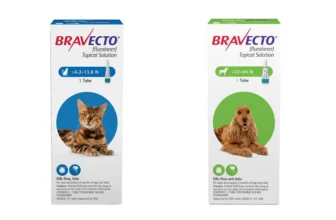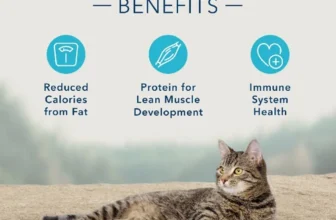As a California Spangled cat owner, you may have noticed your feline friend exhibiting unusual behaviors such as incessant scratching or sneezing. While cats, like humans, can suffer from allergies, it can be hard to determine the cause and provide relief. These allergies can range from food to environmental triggers, and addressing them requires a well-planned approach. In this article, we will examine the symptoms of allergies in California Spangled cats, treatment options available, and preventative measures that can help reduce the likelihood of your furry friend suffering from allergies. So, grab your notepad and let’s get started on helping your cat feel better!
Symptoms of Allergies in California Spangled Cats

Cats, including California Spangled Cats, can develop allergies just like humans. Allergies occur when the immune system reacts to a substance as if it were harmful, even though it is generally not harmful to most. Understanding the symptoms of allergies in your California Spangled Cat is crucial in providing the correct treatment. Certain symptoms may overlap with other health issues, but with proper observation, you can identify when your cat is experiencing an allergic reaction. Let’s take a look at some of the most common symptoms your California Spangled Cat may exhibit when dealing with allergies.
Scratching and Biting
California Spangled Cats who have allergies may exhibit scratching and biting as one of the symptoms. They may constantly scratch and bite at their skin, causing redness, irritation, and hair loss. The affected area may be limited to specific areas, such as the feet or head, or it may be more widespread. The constant biting and scratching may also lead to the formation of scabs and open wounds on the skin.
If left untreated, scratching and biting can lead to further health complications, such as bacterial infections. Hence, it is essential to observe your cat’s behavior and consult a vet at the earliest sign of skin issues.
Your vet may suggest an elimination diet to identify the root cause of the allergies. Alternatively, they may recommend allergy testing to determine the specific allergen that is causing the skin irritation. Certain medications and natural remedies such as Omega-3 fatty acid supplements, antihistamines and steroids may also be prescribed to alleviate the symptoms.
To prevent further scratching or biting, pet parents can ensure that their California Spangled Cat’s environment is clean and free of irritants, and they may consider using hypoallergenic grooming products that are free from harsh chemicals. Additionally, keeping your cat occupied with toys or engaging them in playtime can help distract them from constant scratching or biting.
If you notice your California Spangled Cat constantly biting or scratching, it may be a sign of allergies. With the right treatment and preventative measures, you can help soothe your cat’s skin and keep them healthy and happy.
Coughing and Sneezing
One of the symptoms of allergies in California Spangled cats is coughing and sneezing. Just like humans, cats can experience respiratory symptoms when they are allergic to something. If your cat appears to be coughing or sneezing more frequently than usual, it could be a sign of allergy.
To be sure, watch for other symptoms of allergies, such as scratching, biting, vomiting, diarrhea, ear infections, and skin rash. If your cat exhibits these symptoms alongside coughing and sneezing, it could be a sign of allergies.
Additionally, coughing and sneezing could be caused by other factors such as hairballs, stress, or infections. If you notice this symptom, observe your cat for any other accompanying signs that could help diagnose the problem. Seek veterinary care if your cat seems to be in distress or if the symptoms persist for more than a few days.
To relieve coughing and sneezing, there are a few things you can do. You can provide your California Spangled cat with a humidifier to moisten the air and relieve respiratory symptoms. Also, make sure to provide your cat with a clean litter box and provide regular grooming sessions. Diet can also play a role in reducing these symptoms.
Regular grooming can help to reduce allergens on your cat’s skin and coat, leading to less irritation and respiratory symptoms. This involves brushing your cat’s fur regularly and wiping them down with a damp cloth.
To conclude, coughing and sneezing are common symptoms of allergies in California Spangled cats. If you notice these symptoms in your cat, observe them for any accompanying symptoms and consider getting them veterinary care. Regular grooming sessions and environmental changes can help to alleviate these symptoms and create a more comfortable environment for your beloved feline.
Vomiting or Diarrhea
Vomiting or diarrhea in your California Spangled Cat can be indicative of allergies. If you notice your feline friend experiencing these symptoms more often than usual, it’s important to pay attention and assess their overall health to determine the best course of action.
Vomiting can be mild or severe and can occur for several reasons including food allergies or other allergic reactions. If your cat is vomiting regularly, this could lead to dehydration or other health problems. It is important to monitor your cat’s behavior and contact a veterinarian if vomiting persists. In some cases, hairballs may be the underlying cause of frequent vomiting. To help prevent hairballs, consider regular grooming sessions. For more information on hairballs in California Spangled Cats, check out our article.
Diarrhea can also be caused by allergens, such as certain types of food. In some cases, diarrhea can lead to dehydration. If diarrhea is present, make sure your cat gets lots of fluids and electrolytes. If the symptoms persist, it is important to contact a veterinarian to determine the underlying cause. Regular dental check-ups for your cat can also help prevent diarrhea. Learn more about ways to keep your California Spangled Cat’s teeth healthy in our article.
In some cases, vomiting or diarrhea can be a sign of a more serious condition, such as a urinary tract infection or kidney disease. Regular vet check-ups can help catch and treat these conditions early on. Find out more about the importance of regular veterinarian check-ups for your California Spangled Cat in our article.
Ear Infection
Ear infections are another symptom of allergies that California Spangled cats may experience. A cat’s ear infection can be very painful and uncomfortable, and it is important to treat it promptly before it causes any severe damage. Some common signs that your cat may have an ear infection include shaking their head frequently, scratching and pawing at their ears, and emitting a foul odor from their ear canal.
The primary cause of ear infections in California Spangled cats is allergies. When a cat’s immune system reacts to allergens, it can cause inflammation in the ear canal, creating a damp environment that is perfect for bacterial or yeast overgrowth. This is why it’s essential to address underlying allergies that your cat may have to prevent recurring ear infections.
To treat ear infections in California Spangled cats, your veterinarian may prescribe medications such as antibiotics or antifungals depending on the cause of the infection. It’s important to complete the full course of treatment provided by your veterinarian, even if your cat’s symptoms improve to prevent any relapse.
In addition to medication, you can take some measures at home to help relieve your cat’s symptoms. You can use a warm compress to help soothe your cat’s ear, but make sure it’s not too hot that it burns their skin. Also, consider cleaning your cat’s ears gently with a vet-approved ear cleaner to remove any excess wax or dirt buildup.
It’s important to note that while ear infections are treatable, they can be a recurring problem if the underlying allergy is not addressed. As a preventive measure, make sure to schedule regular visits with your veterinarian, keep your cat’s ears clean, and address any allergies promptly to reduce the likelihood of ear infections.
Link to relevant article:
/ca-spangled-cats-kidney-disease/
Skin Rash
One common symptom of allergies in California Spangled cats is skin rash . Cats may develop rashes that appear as red, irritated patches of skin. They may also have scaly or flaky skin, which can be itchy and uncomfortable for them. Skin rash caused by allergies is usually the result of the cat’s immune system reacting to a particular allergen.
It can be challenging to determine the cause of skin rash in cats. However, some common allergens that commonly affect California Spangled cats are flea bites, certain foods, and environmental irritants like pollen or mold. Once the allergen is identified, steps can be taken to minimize exposure.
If you suspect that your California Spangled cat has a skin rash due to allergies, it’s essential to seek veterinary care. Your veterinarian will examine your cat’s skin and might recommend diagnostic testing to confirm the root cause.
Treatment for skin rash in cats typically involves medications like antihistamines or steroids to help relieve itching and inflammation. Frequent bathing with medicated shampoos or soothing treatments may also be helpful to reduce symptoms. A hypoallergenic diet may also be suggested to eliminate symptoms caused by food allergens.
Incorporating natural remedies, such as coconut oil or oatmeal baths, may provide temporary relief for your cat’s skin rash. However, it is important to check with your veterinarian before trying any natural remedies. Some home remedies can make symptoms worse or have adverse reactions to medications.
Skin rash caused by allergies can be uncomfortable for California Spangled cats. It’s crucial that cat owners are aware of the signs and symptoms of allergies and seek veterinary care if they suspect their cat is suffering from allergies. Working closely with your veterinarian to find the root cause of your cat’s skin rash and minimizing exposure to allergens will help in providing your California Spangled cat with relief.
Treatment Options for Allergies in California Spangled Cats

Treating allergies in California Spangled cats can be a challenging task for pet owners. Allergies can cause discomfort and pain to your cat, affecting their overall health and well-being. However, there are various treatment options available that can help alleviate symptoms and improve your cat’s quality of life. Let’s explore some of the most effective treatments for allergies in California Spangled cats.
Elimination Diet
An elimination diet is a process of identifying food allergens that affect your California Spangled Cat. You need to remove all ingredients from their diet that could be potential allergens. Start with a simple diet, including just one protein and one carbohydrate for a few weeks, and then slowly reintroduce the eliminated ingredients one by one. If your cat shows signs of an allergic reaction, it indicates that it’s allergic to that specific ingredient. Common allergens include chicken, beef, pork, soy, fish, eggs, and dairy products.
This process can be a little tricky, as your cat may not like the new diet, or the diet may not be nutritionally complete. To ensure your cat’s health, always consult a veterinarian before starting this process.
During the elimination diet, you can feed your cat novel protein sources, such as rabbit or venison, that they have not eaten before. This is because, generally, California Spangled Cats have not been exposed to these proteins, so they won’t be allergic to them. Prescription diets are also available, which contain hydrolyzed protein. This means that the protein has been broken down into tiny particles that are not recognized as allergens by the immune system.
“An elimination diet is a gold standard for diagnosing food allergies in cats,” according to Dr. Karen Becker who is a proactive and integrative wellness veterinarian. “It can be time-consuming and complicated, but it is highly effective and prevents your cat from experiencing severe allergic reactions.”
Some additional benefits of the elimination diet include weight loss, improvement in urinary tract infections, reduction in stress, and resolving skin conditions. A healthy, well-balanced diet has many positive effects on your California Spangled Cat’s overall health, and it’s worth the effort to find out which foods your cat can and can’t eat.
If you suspect that your cat has food allergies, consult your veterinarian before starting an elimination diet. They can guide you through the process and ensure it’s safe and effective for your cat’s health.
UTIs in California Spangled Cats can be prevented by managing their diet and ensuring that they are consuming the right nutrients. If you’re worried about your cat’s health, speak to your veterinarian about an elimination diet and any necessary treatments to ensure they live a long and happy life.
Allergy Testing
Allergy testing is an effective way to determine the specific allergen that is causing a California Spangled Cat’s allergy symptoms. There are different types of allergy testing available, and the best approach will depend on the cat’s individual situation.
Skin Testing: A small amount of the suspected allergen is injected into the cat’s skin. If a raised bump appears at the injection site, it indicates an allergic reaction. This test is a relatively quick and straightforward way to determine several allergies at once. It can identify allergies to a wide range of substances including pollen, dust mites, food, and insect bites.
Blood Testing: A blood sample is taken from the cat and sent to a laboratory to test for specific allergens. This method is less invasive than skin testing but may not be as accurate. Blood testing can identify allergies to substances such as pollen, mold, and certain types of food. It can also be used to measure the cat’s response to treatment over time.
Elimination Diet: An elimination diet involves removing certain foods from the cat’s diet and reintroducing them one at a time to determine if there is an allergic reaction. This method can be effective for identifying food allergies, but it can be time-consuming and requires strict adherence to the diet.
It’s essential to consult with a veterinarian before conducting any allergy testing or elimination diets. They can provide guidance and help determine the best approach for the individual cat’s situation. Understanding the specific allergen causing the cat’s symptoms can lead to more targeted treatment options and a better quality of life for the cat. If you suspect your California Spangled Cat has allergies, consult with a veterinarian to determine the best course of action.
To learn more about other conditions that can affect California Spangled Cats, check out our article on skin conditions, as well as our guide to managing stress and obesity in these unique felines.
Medications
Medications are a common method for treating allergies in California Spangled Cats. There are several types of medications that can help manage the symptoms of your cat’s allergies. It’s important to consult with a veterinarian before giving your cat any medication.
Antihistamines: These medications work by blocking the effects of histamine, a chemical released by the body in response to an allergic reaction. Common antihistamines include Benadryl and Chlorpheniramine. Antihistamines can cause drowsiness in cats, so it’s important to follow your veterinarian’s instructions for dosage.
Corticosteroids: Corticosteroids are anti-inflammatory medications that can reduce swelling and itching caused by allergies. These medications can be given by pill, injection, or topical cream. Common corticosteroids include Prednisolone and Dexamethasone. Long-term use of corticosteroids can have side effects, so it’s important to work with your veterinarian to determine the appropriate dosage for your cat.
Immunotherapy: Immunotherapy, also known as allergy shots, is a long-term treatment option for cats with severe allergies. This treatment involves injecting small amounts of the allergen into the cat’s body over a period of time to help the cat build up immunity to the allergen. Immunotherapy is typically more expensive than other treatment options and requires frequent visits to the veterinarian.
Topical Medications: Topical medications, such as creams or sprays, can be used to treat skin rashes or other skin irritations caused by allergies. These medications usually contain corticosteroids to help alleviate symptoms. It’s important to follow your veterinarian’s instructions when applying topical medications to avoid overuse.
| Type of Medication | Example | Administration | Side Effects |
|---|---|---|---|
| Antihistamines | Benadryl | Pill form | Drowsiness |
| Corticosteroids | Prednisolone | Pill, injection, or topical cream | Increased thirst and urination, weight gain, mood changes |
| Immunotherapy | Allergen-specific immunotherapy | Injection | Can cause allergic reactions |
| Topical Medications | Hydrocortisone cream | Topical application | Skin irritation |
Remember, medication alone is not enough to treat your cat’s allergies. A combination of medication and other treatment options, such as environmental changes and regular grooming, can help manage your cat’s symptoms and improve their overall quality of life.
Natural Remedies
When it comes to treating allergies in California Spangled cats, many pet owners prefer to opt for natural remedies. While these remedies may not have been extensively researched, many people find them to be effective in managing symptoms. Here are some commonly used natural remedies for allergies in California Spangled cats:
| Remedy | Description |
|---|---|
| Probiotics | Probiotics can help boost your cat’s immune system and reduce inflammation in the body. They can be found in supplement form or in certain types of food like yogurt. |
| Fish Oils | Fish oils are rich in omega-3 fatty acids, which can help reduce inflammation in the body and improve skin health. |
| Coconut Oil | Coconut oil is believed to have anti-inflammatory and antibacterial properties, which can help reduce allergy symptoms and prevent infections. |
| Quercetin | Quercetin is a natural antihistamine found in certain foods like apples and onions. It can also be taken in supplement form to help reduce allergy symptoms. |
| Herbal Supplements | Various herbal supplements, such as chamomile, licorice root, and nettle, are believed to have anti-inflammatory and antihistamine properties that may help reduce allergy symptoms. |
| Apple Cider Vinegar | Apple cider vinegar is believed to have anti-inflammatory properties and may help soothe itchy skin. It can be applied topically or added to your cat’s food. |
While natural remedies may be effective for some cats, it’s important to remember that they may not work for everyone. If your cat’s allergy symptoms are severe or persistent, it’s best to consult with your veterinarian to determine the best course of treatment. It’s also important to ensure that any natural remedies you give your cat are safe and appropriate for their individual needs.
Environmental Changes
One way to help your California Spangled cat with allergies is by making environmental changes in your home. This can involve altering the environment to eliminate allergens that may trigger your cat’s allergy symptoms. Here are some environmental changes you can make:
| Environmental Changes | Details |
|---|---|
| Use an Air Purifier | An air purifier can remove allergens from the air, such as dust, pollen, and mold spores. Place the air purifier in a room where your cat spends a lot of time, such as the living room or bedroom. |
| Clean Bedding Frequently | Wash your cat’s bedding in hot water every week to eliminate any dust mites or other allergens. Use fragrance-free detergent, as scented products can also trigger allergies in some cats. |
| Vacuum and Dust Regularly | Use a vacuum with a HEPA filter to clean carpets and upholstery. Dust surfaces with a damp cloth or microfiber cloth to trap allergens. Make sure to dust areas that are often overlooked, such as the tops of bookshelves and ceiling fans. |
| Use Natural Cleaning Products | Avoid using cleaning products that contain harsh chemicals or fragrances, as these can trigger allergies. Instead, opt for natural cleaning products that are safe for pets, such as vinegar and baking soda. |
| Eliminate Cigarette Smoke | Cigarette smoke can irritate your cat’s lungs and exacerbate allergy symptoms. If you smoke, try to quit, or smoke outside away from your cat. If you have guests who smoke, ask them to smoke outside as well. |
By making these environmental changes, you can help reduce your cat’s exposure to allergens, making them feel more comfortable and reducing their allergy symptoms.
Preventative Measures for Allergies in California Spangled Cats
When it comes to cat allergies, prevention is key to keeping your California Spangled feline free from discomfort and allergic reactions. While treatments exist to alleviate allergy symptoms, taking preventative measures can save you time, money, and stress in the long run. By taking steps to avoid allergens and improve your cat’s environment, you can help keep your California Spangled cat healthy and happy. Here are some tips and tricks for preventing allergies in your feline companion.
Regular Grooming Sessions
One of the best preventative measures to reduce allergies in California Spangled cats is to schedule regular grooming sessions. This is because grooming can help remove the allergens that are attached to a cat’s fur. Here are some tips on how to effectively groom your California Spangled cat:
- Brushing: Brush your cat’s fur regularly, which can help remove loose fur and distribute natural oils throughout their fur, keeping it healthy and shiny. It also helps to prevent hairballs, which can trigger allergic reactions in cats. Use a soft brush for short hair and a slicker brush for long hair.
- Bathing: Bathing your cat on a regular basis can help remove environmental allergens, like pollen, dust, and mold spores that are stuck on their fur. Use a cat-specific shampoo and warm water. Avoid making the water too hot so that your cat doesn’t get burned.
- Eyes and Ears: Use a damp cloth to wipe around your cat’s eyes and ears, carefully cleaning any discharge or dirt that has accumulated. You can also use a specialized cleaner for their eyes and ears that you can purchase from a vet.
- Nail clipping: Regularly clipping your cat’s nails not only helps to prevent damage to your furniture, but it also reduces the likelihood of them scratching and biting areas of their skin that can become infected or inflamed. Use special cat clippers and be careful not to cut the quick or the nerve in their nails.
By incorporating regular grooming sessions into your cat’s routine, you can help reduce the allergens that are present in their environment and give them a comfortable and healthy life.
Avoiding Environmental Triggers
For California Spangled cats with allergies, avoiding environmental triggers can greatly reduce their symptoms. Here are some common triggers and ways to avoid them:
| Environmental Trigger | Avoidance Tips |
|---|---|
| Dust Mites | Wash bedding and toys frequently in hot water, vacuum regularly, use allergen-proof covers on bedding |
| Pollen | Keep windows and doors closed during high pollen seasons, wipe down paws and face after being outside, use air purifiers with HEPA filters |
| Mold | Fix any sources of moisture in the home, use dehumidifiers, clean mold immediately when you see it |
| Perfumes/Colognes | Avoid wearing strong scents around your cat, use unscented household cleaners and personal care products |
| Cigarette Smoke | Avoid smoking around your cat, ventilate your home well, and ask guests to smoke outside |
By taking these avoidance measures, you can significantly reduce the amount of allergens your California Spangled cat is exposed to, helping them breathe and feel better overall.
Improving Air Quality
As a California Spangled cat owner, it is crucial to understand that the quality of air in your home can significantly impact your cat’s allergies. Making a few changes to your home can not only help alleviate existing allergy symptoms but can also prevent them from reoccurring. Here are some ways to improve the air quality in your home:
- Use an air purifier: Air purifiers work by trapping allergens, dust, and other pollutants in the air, which can help prevent your cat from inhaling these irritants and experiencing allergy symptoms. Be sure to choose an air purifier that is specifically designed for pet allergies and has a HEPA filter.
- Regularly clean your HVAC system: Dust, pet hair, and other allergens can accumulate in your HVAC system over time, ultimately circulating throughout your home. Make sure to replace air filters monthly, clean air ducts on a regular basis, and maintain a consistent temperature and humidity level in your home.
- Ventilate your home: Fresh air can help reduce indoor allergens, so be sure to open windows and doors whenever possible. This will help increase circulation and reduce the buildup of potentially harmful contaminants.
- Keep your home clean: Dust and other allergens can accumulate quickly in your home, so make sure to regularly clean surfaces, vacuum carpets, rugs, and furniture, wash your cat’s bedding, and use allergen-proof covers for your mattress and pillows. This will help reduce the amount of allergens in the air.
- Avoid smoking indoors: Smoking indoors can lead to a buildup of harmful pollutants, seriously affecting your cat’s respiratory system, and worsening allergy symptoms. If you or your family members smoke, try to do so outside your home.
By taking these steps to improve your home’s air quality, you can help relieve your California Spangled cat’s allergy symptoms and ensure a healthy and happy life for your furry friend.
Conclusion
In conclusion, dealing with allergies in California Spangled cats can be a challenging but manageable task. It is essential to recognize the symptoms of allergies early on to provide timely treatment and prevent further complications.
Regular grooming can go a long way in preventing allergic reactions. Keeping your pet clean and neat will reduce the chances of allergens accumulating on their coat and causing irritation.
Avoiding environmental triggers can also be quite helpful. If you know that your cat is allergic to a specific substance, it is important to keep them away from it as much as possible. It can be helpful to identify and avoid other environmental triggers that may cause allergic reactions as well.
Improving air quality can make a significant difference in your cat’s overall health and well-being. Consider investing in an air purifier to help remove allergens from the air.
It is crucial to work with your veterinarian to identify the cause of your cat’s allergies and develop a treatment plan that is right for your pet. This may include medications or natural remedies, but a elimination diet or allergy testing may be necessary in some cases.
Remember that allergies can affect your cat’s quality of life, so it’s crucial to take all the necessary steps to manage and prevent them. By following the tips discussed in this article, you can help your California Spangled cat lead a happy, healthy life, and keep allergies at bay.
Frequently Asked Questions
Can California Spangled Cats develop allergies?
Yes, just like any other cat, California Spangled Cats can develop allergies. They may be allergic to certain foods, environmental factors, or even grooming products.
How can I tell if my California Spangled Cat has allergies?
If your cat is scratching excessively or has a skin rash, coughing and sneezing, experiencing gastrointestinal issues, or developing frequent ear infections, they may be suffering from allergies.
What is an elimination diet and how can it help my cat’s allergies?
An elimination diet involves removing certain foods from your cat’s diet to pinpoint which ones are causing their allergic reactions. This can be a helpful tool in managing your cat’s allergies moving forward.
What kind of allergy testing can be done for California Spangled Cats?
There are various allergy tests that can be performed, including skin tests or blood tests, to determine what specific allergens your cat is reacting to.
Can California Spangled Cats be given human allergy medication?
No, you should never give your cat human medication without consulting with a veterinarian first. Some human medications can be toxic for cats.
What are some natural remedies I can try to alleviate my cat’s allergies?
Some natural remedies that may help alleviate allergies in cats include using a neti pot to flush their sinuses, incorporating probiotics into their diet, or using herbal remedies like chamomile or lavender.
What kind of environmental changes can I make to help my cat’s allergies?
You can try using a HEPA air filter, keeping your home clean and dust-free, or removing any potential allergens such as mold or pollen from your cat’s living space.
Can allergies be completely cured in California Spangled Cats?
Allergies cannot be completely cured, but they can be managed with proper treatment and preventative measures.
Should I seek veterinary care if my California Spangled Cat has allergies?
Yes, it’s important to seek veterinary care if you suspect your cat has allergies. A veterinarian can help determine the cause of their allergies and provide treatment options.
Is it possible for my California Spangled Cat to develop new allergies over time?
Yes, just like humans, cats can develop new allergies over time. It’s important to stay vigilant and monitor your cat’s behavior and health for any potential allergic reactions.







